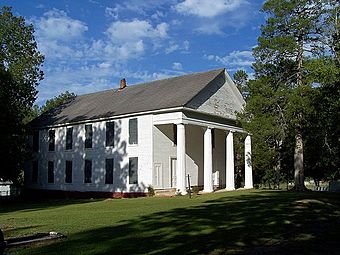Long Cane Associate Reformed Presbyterian Church facts for kids
Quick facts for kids |
|
|
Long Cane Associate Reformed Presbyterian Church
|
|
 |
|
| Nearest city | Troy, South Carolina |
|---|---|
| Area | 4.9 acres (2.0 ha) |
| Built | 1790 |
| Architect | Jones, William Henry |
| Architectural style | Greek Revival |
| NRHP reference No. | 98000426 |
| Added to NRHP | October 06, 1999 |
The Long Cane Associate Reformed Presbyterian Church is a very old and important church located in McCormick County, South Carolina. It's about four miles west of Troy, South Carolina, right on SC 33-36. Next to the church building, there's a cemetery that dates back to around 1790.
This church is so important that it was added to the National Register of Historic Places in 1999. This means it's recognized as a special historical site in the United States.
Church History
The Long Cane church started way back in 1771. It began as an Associate Presbyterian congregation. This was one of several churches started before the American Revolution (the war when America became independent). A man named Dr. Thomas Clark helped set up these churches.
Dr. Clark and about 100 families moved from Ireland in 1764. They first settled in New York. But soon, some families moved south to South Carolina. They settled near Long Cane Creek, in an area then called "the Calhoun settlement."
Dr. Clark himself moved to South Carolina in 1782. He served as the minister for Long Cane and other nearby churches. He went back North for a short time but returned after the American Revolution. He stayed at Long Cane until he passed away.
The first group of people at Long Cane were called "the Fort Boone congregation." This is because the church, school, and safety were all found within the walls of Fort Boone. These fortifications were built after a time of danger from conflicts with Native Americans in 1760.
The original Long Cane congregation joined with the Cedar Springs Church in 1786. They later separated in 1808. Some members then joined the Presbyterian Church between 1818 and 1819. But they reunited with the Cedar Springs Church again from 1828 to 1892.
The Church Building
The church building you see today was finished in 1856. It was built by William Henry Jones from Atlanta. The style of the building is called Greek Revival. This means it looks a bit like ancient Greek temples.
Dr. Sloan officially opened the church on July 20, 1856. He gave a sermon from a Bible verse, Habakkuk 2:20. The verse says, "But the Lord is in His Holy Temple; let all the earth keep silent before Him."
The church is made of wood and is quite large, about 44 by 64 feet. It has a 10-foot porch and a balcony (called a gallery) on three sides inside. The building is mostly the same as when it was built. However, small rooms were added near the pulpit in 1892. This was when the church stopped using the "Session House." The Session House was a separate building behind the church that was used for meetings and as a school.
The church's cemetery has over 500 graves. Many of the first members of the Long Cane church are buried there. These early members were very important in helping the Associate Reformed Presbyterian Church grow. The church building sits on a foundation of handmade brick pillars. Later, a brick wall was added between these pillars.
The front of the church has a grand entrance with four large columns. These columns support a triangular roof section, like you might see on a Greek temple. The roof was originally made of wooden shingles. Around 1950, it was covered with diamond-shaped asbestos shingles. A small brick chimney sticks out from the center of the roof.
Inside, the main worship area is two stories high. The walls and ceiling are made of smooth wooden boards. The balcony has a continuous wooden railing and simple, handmade wooden pews (church benches).
Past Ministers
Here is a list of the ministers who have served the Long Cane Associate Reformed Presbyterian Church:
- Rev. Thomas Clark, 1786–1791
- Rev. Peter McMullen, (interim)
- Rev. Alex Porter, 1797–1803
- Rev. John T. Pressly, 1828–1831
- Rev. W. R. Hemphill, 1837–1848
- Rev. H. T. Sloan, 1850-1890
- Dr. Robert Foster Bradley, 1891–1930




